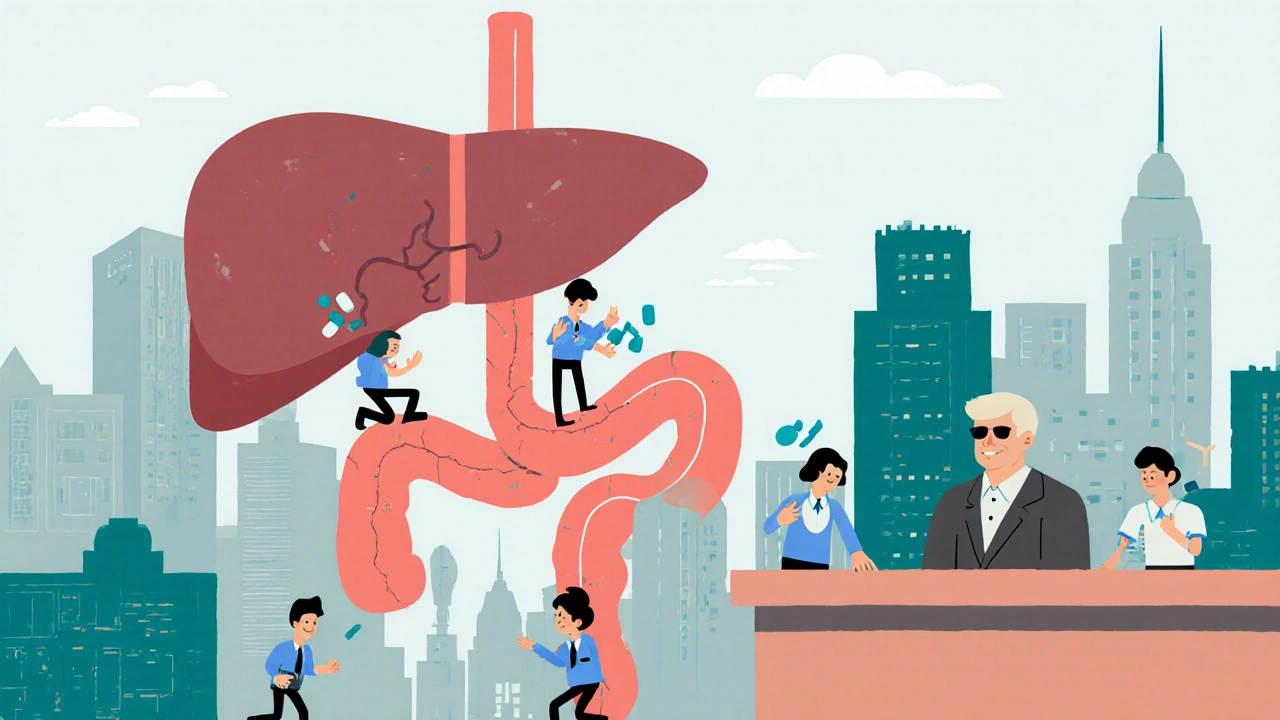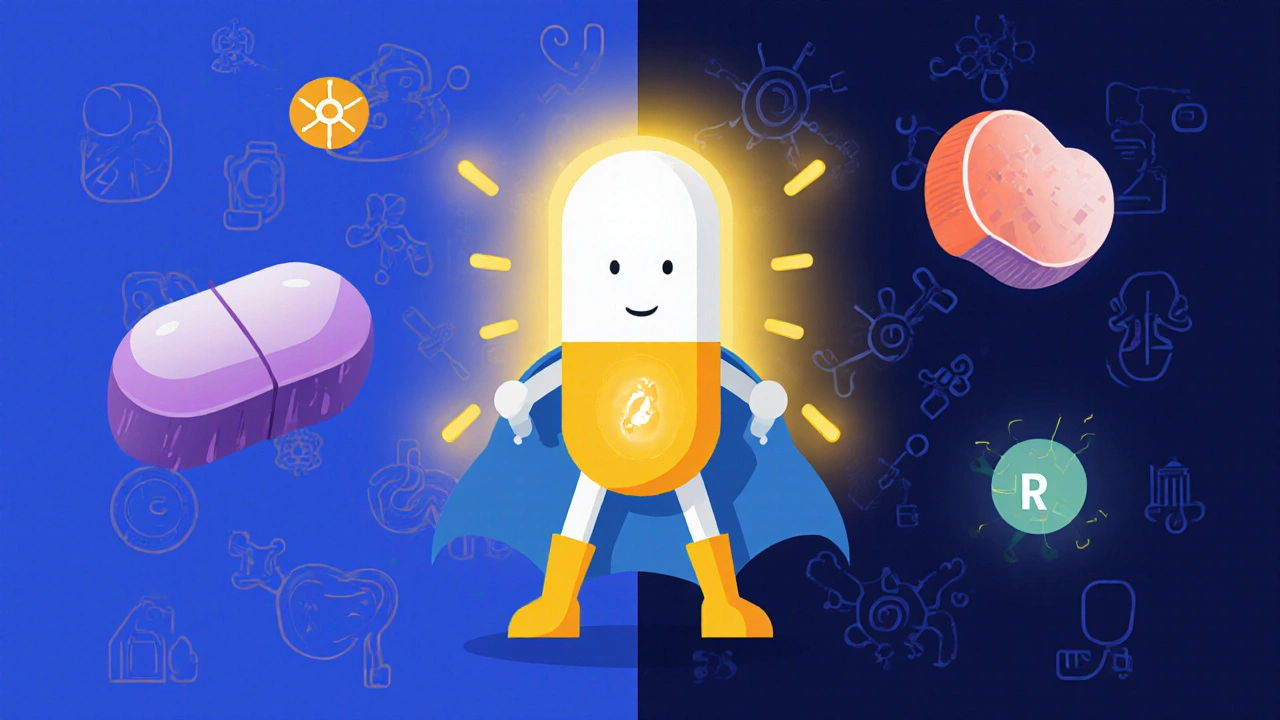
Antiviral Drug Interaction Checker
Enter an antiviral medication and another drug to see potential interactions involving CYP3A4 or P-glycoprotein
When you’re taking antiviral medications-whether for HIV, hepatitis C, or something else-you’re not just managing one drug. You’re managing a whole system. And two of the biggest players in that system are CYP3A4 and P-glycoprotein. These aren’t just technical terms. They’re biological gatekeepers that decide how much of your medicine actually gets into your bloodstream, how long it stays there, and whether it’ll clash with your other pills. Ignoring them can mean the difference between treatment working-and ending up in the hospital.
What CYP3A4 and P-glycoprotein Actually Do
CYP3A4 is the most common enzyme in your liver and gut. It breaks down about half of all the drugs you take. Think of it like a factory that chops up medication so your body can get rid of it. Then there’s P-glycoprotein, or P-gp. It’s a transporter that acts like a bouncer at the door of your cells. It kicks drugs out before they can get absorbed in your gut or hang around too long in your brain or kidneys.
Together, they control how much of your antiviral actually reaches the virus. If CYP3A4 breaks it down too fast, the drug won’t work. If P-gp kicks it out too soon, it never gets into the cells where it’s needed. But here’s the twist: many antivirals don’t just get affected by these systems-they actively mess with them.
Ritonavir: The Original Game-Changer
Ritonavir was first approved in 1996 to treat HIV. But doctors quickly noticed something strange. When they gave it at low doses-just 100 mg a day-it didn’t really kill the virus. Instead, it made other HIV drugs work better. That’s because ritonavir is a powerful inhibitor of CYP3A4. It shuts down the enzyme so other drugs aren’t broken down as quickly. That means higher levels in the blood, longer lasting effects, and fewer pills needed.
That’s how boosting was born. Today, ritonavir is rarely used alone. It’s used as a booster-paired with drugs like lopinavir, darunavir, or even some hepatitis C treatments. But here’s the catch: ritonavir doesn’t just inhibit CYP3A4. It also induces CYP1A2, another enzyme. That means it can make some drugs work less, even while boosting others. A 2017 meta-analysis showed it increases alprazolam levels by 305% but drops olanzapine levels by 29%. That’s not just complicated-it’s dangerous if you’re on multiple meds.
P-glycoprotein: The Silent Player
While everyone talks about CYP3A4, P-gp gets ignored. But it’s just as important. Many direct-acting antivirals (DAAs) for hepatitis C-like grazoprevir, paritaprevir, and ombitasvir-are P-gp substrates. That means P-gp tries to push them out of your gut before they’re absorbed. If you take something that blocks P-gp-like ritonavir-those antivirals get absorbed way more easily. That sounds good, right? Not always.
That same boost can make other drugs too strong. Ritonavir’s inhibition constant for P-gp is 3.2 μM. That means it can increase digoxin levels by 2.8 times. Digoxin is used for heart rhythm. Too much can cause deadly arrhythmias. In one 2021 study, healthy volunteers taking ritonavir and digoxin together saw digoxin levels climb into the toxic range. No one knew until they got dizzy and nauseous.

How Different Antivirals Compare
Not all antivirals are created equal when it comes to interactions.
For HIV:
- Ritonavir (boosted): AUC increase of 11.3 for midazolam (a classic CYP3A4 test drug)
- Cobicistat: AUC increase of 5.1-stronger than most, but doesn’t induce CYP1A2
- Darunavir alone: AUC increase of just 1.2-minimal interaction
For hepatitis C:
- Paritaprevir/ritonavir/ombitasvir/dasabuvir: 42% of common drugs need dose changes
- Glecaprevir/pibrentasvir: Only 17% need changes
- Sofosbuvir: Minimal CYP interaction-but still affected by P-gp
One of the worst offenders? The paritaprevir/ritonavir combo. It can spike simvastatin levels by 1,760%. Simvastatin is for cholesterol. Too much can cause muscle breakdown, kidney failure, even death. The FDA label warns about this. But doctors still miss it.
The Real-World Cost of Missing Interactions
A 2021 study in The Lancet Infectious Diseases tracked 4,892 patients with HIV and hepatitis C across Europe. They found that 17.3% of adverse drug events were caused by uncaught interactions. That’s nearly one in five. Many of these weren’t minor rashes or headaches. They were bleeding, organ failure, hospitalizations.
One case from 2021: a 68-year-old man on apixaban (a blood thinner) started darunavir/cobicistat. His anti-Xa levels-normally 50-250 ng/mL-shot up to 384 ng/mL. He bled internally. He nearly died.
On the flip side, clinics that started using the University of Liverpool HIV Drug Interactions Checker saw interaction-related problems drop from 18.7% to 5.2% in just one year. That’s a 72% reduction. The tool is free, easy to use, and updated weekly. But only 68% of U.S. clinics use it. In Europe? 92% do.
Hidden Risks: Herbs, Food, and Supplements
It’s not just prescription drugs. Herbal supplements can be just as dangerous.
- St. John’s wort: Decreases ritonavir levels by 57%. That’s enough to let HIV rebound.
- Grapefruit juice: Increases ritonavir by 23%-enough to push some patients into toxicity.
- Cyclosporine: When taken with grazoprevir, it causes a 17.3-fold spike in drug levels. This combo is outright contraindicated.
Patients don’t always tell their doctors about these. They think ‘natural’ means safe. It doesn’t. A 2022 study found that 41% of HIV patients were taking herbal products, and only 19% had told their provider.
How to Protect Yourself
Here’s what actually works:
- Make a full list of everything you take-prescriptions, OTC, vitamins, herbs. Even the ones you only take once a month.
- Use the Liverpool app. It’s free. It’s updated daily. It tells you if your meds clash. Use it before starting any new antiviral.
- Ask your pharmacist. They’re trained for this. Don’t assume your doctor knows every interaction.
- Don’t start new meds without checking. Even something as simple as ibuprofen or omeprazole can interact.
- Wait before adding blood thinners. If you’re on ritonavir or cobicistat, wait at least a month before starting apixaban, rivaroxaban, or warfarin. Let your body stabilize first.
The Future: Simpler Drugs, Bigger Challenges
The good news? New antivirals are getting smarter. Lenacapavir, approved in 2022, has almost no CYP or transporter interactions. That’s huge. It’s a shot given twice a year. No daily pills. No boosting. No interactions.
But here’s the problem: we’re treating more people than ever. By 2025, 39 million people worldwide will be on antiretrovirals. And they’re getting older. The average person with HIV now has 4.7 other health conditions-diabetes, heart disease, depression, kidney issues. Each one means more drugs. More chances for a bad interaction.
Dr. Melanie Thompson put it bluntly at the 2023 Retroviruses Conference: ‘The next frontier isn’t viral load. It’s managing the 4.7 comorbidities per person. That’s where CYP and transporters will make or break treatment.’
So yes, the science is complex. But the solution isn’t. Know your meds. Check your interactions. Don’t guess. Use the tools that exist. Because when it comes to antivirals, the difference between success and disaster isn’t always the drug. It’s whether you knew what it was doing to your body-and what your body was doing to it.





